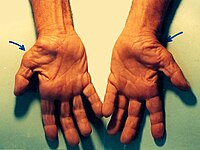
Photo from wikipedia
Background: Motor branch of the ulnar nerve (MUN) injury during carpal tunnel surgery is rare and it should never be injured during carpal tunnel release (CTR). However, an iatrogenic injury… Click to show full abstract
Background: Motor branch of the ulnar nerve (MUN) injury during carpal tunnel surgery is rare and it should never be injured during carpal tunnel release (CTR). However, an iatrogenic injury of the MUN can cause catastrophic physical and mental suffering. The aim of our study is to understand the anatomy of the MUN in relation to carpal tunnel in order to prevent iatrogenic injury during CTR. Methods: We dissected 34 fresh cadaver hands and located the MUN in relation to the anatomical axis used for carpal tunnel surgery. Possible mechanisms of injury and the vulnerable area of the MUN were determined along the dissection. Results: The MUN turned towards the thumb distal to hook of hamate. It then travelled on the floor of the carpal tunnel which was formed by intrinsic hand muscles under flexor tendons. The nerve located at 29.39 ± 7.41, 35.01 ± 3.14 and 38.79 ± 4.03 mm (Mean ± SD) in the central axis of ring finger, the vertical axis of the third web-space and the central axis of middle finger respectively. The nerve's turning point, 10.9 ± 2.63 mm distal to the centre of hook of hamate where it lies just below the level of the transverse carpal ligament. Conclusions: Surgeons should be aware of the nerve's location. Surgical dissection or passing of any surgical instruments around the hook of hamate should be done with care. Level of Evidence: Level IV (Therapeutic).
Journal Title: The journal of hand surgery Asian-Pacific volume
Year Published: 2023
Link to full text (if available)
Share on Social Media: Sign Up to like & get
recommendations!